Hol Dir den wöchentlichen SPARTANAT-Newsletter.
Dein Bonus: das gratis E-Book von SPARTANAT.
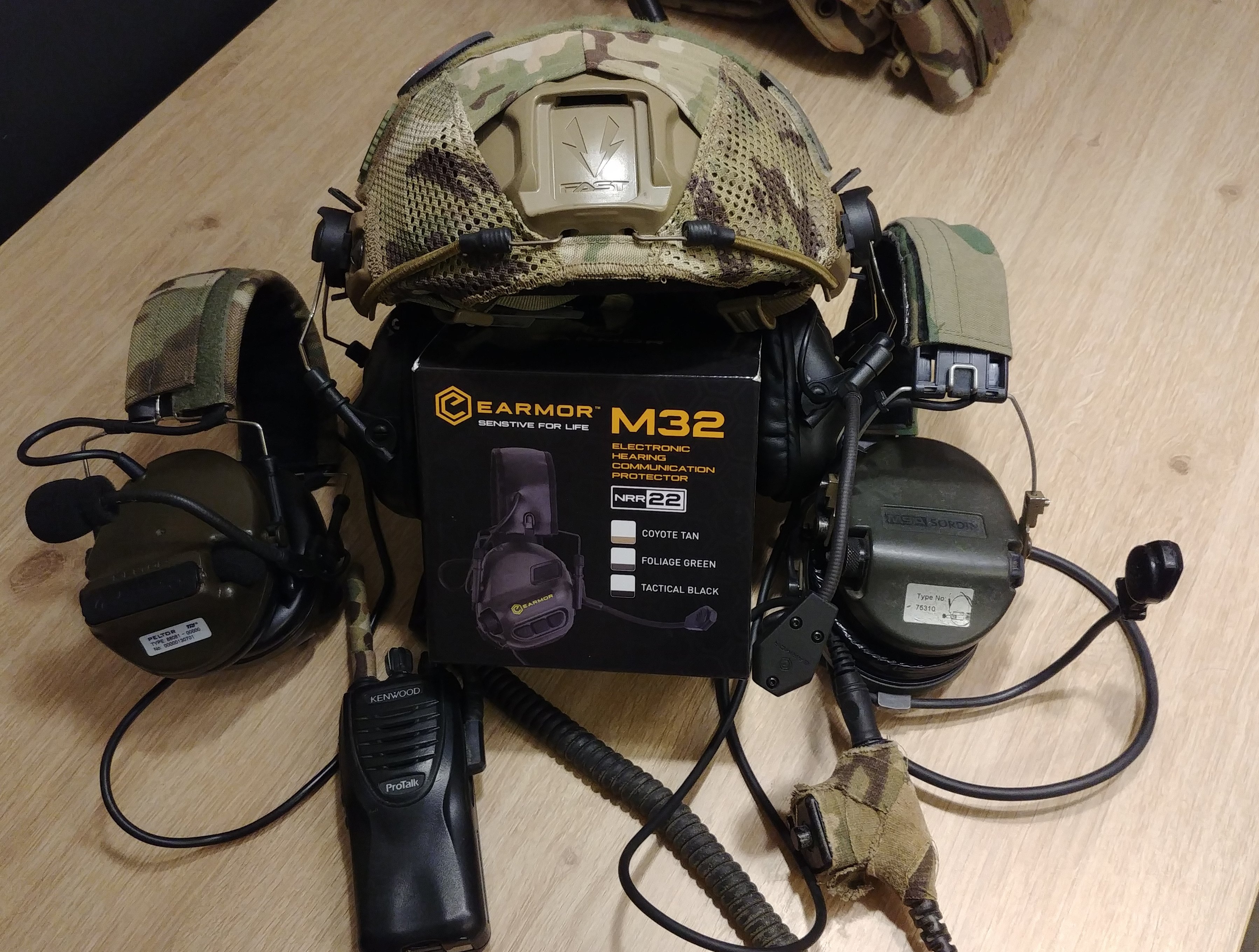
REVIEW: EARMOR M32 Gehörschutz
Ein elektronischer Gehörschutz für den Schießplatz? Und das zum Drittel vom Preis (oder weniger)?
Ein elektronischer Gehörschutz für den Schießplatz? Und das zum Drittel vom Preis (oder weniger)? So ungefähr haben wir uns gefragt, als wir Earmor zum ersten Mal erblickt haben. Doch was kann das Headset, das mit 3M Peltor und MSA Sordins in einer Liga spielen will? Das sehen wir uns heute im Review genauer an.
Wir haben uns für das M32H Modell entschieden. Dieses hat ein Mikrofon für die Funke dabei und lässt sich direkt auf Helmen mit OpsCore Schienen montieren. Preislich liegen die Earmor Headsets zwischen 59-75 Euro.
Und wir sagen es gleich voran: Bitte beachtet, dieses Review bezieht sich nicht auf die neuen MOD1 Modelle. Mehr dazu am Ende des Reviews.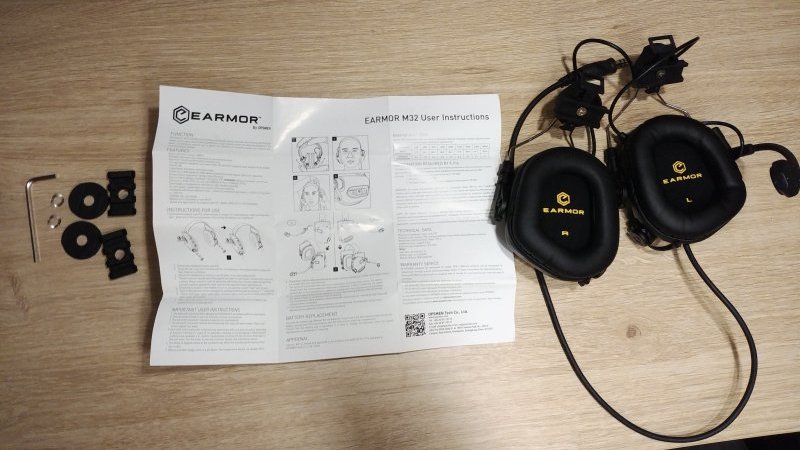 Ausgepackt erhält man folgendes: Headset, Anleitung und zusätzlich noch Kleinteile wie etwa eine RIS Schiene, welche man auf die Schienenadapter aufschrauben kann.
Ausgepackt erhält man folgendes: Headset, Anleitung und zusätzlich noch Kleinteile wie etwa eine RIS Schiene, welche man auf die Schienenadapter aufschrauben kann.  Auf der linken Seite befindet sich ein Warnsticker. Dieser warnt davor, dass der Gehörschutz lediglich nur eine Schicht an Schutz bietet und bei längerer Nutzung in sehr lauter Umgebung Ohrstöpsel verwendet werden sollten. Dies empfiehlt sich unabhängig von diesem Gehörschutz auch für längeres Schießen in geschlossenen Räumen.
Auf der linken Seite befindet sich ein Warnsticker. Dieser warnt davor, dass der Gehörschutz lediglich nur eine Schicht an Schutz bietet und bei längerer Nutzung in sehr lauter Umgebung Ohrstöpsel verwendet werden sollten. Dies empfiehlt sich unabhängig von diesem Gehörschutz auch für längeres Schießen in geschlossenen Räumen. 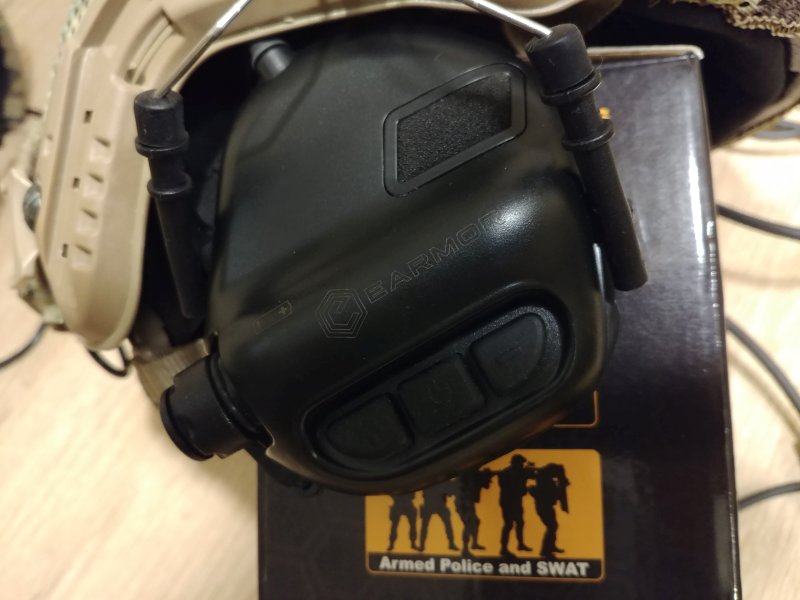 Auf der rechten Seite befinden sich die Bedienknöpfe. Mit diesen lässt sich das Headset einschalten und die Lautstärke zwischen vier Stufen einstellen. Die generelle Verarbeitung ist in Ordnung und die Ohrschalen sind auch mit dickerem Kunststoff ausgestattet, um diese langlebiger zu machen.
Auf der rechten Seite befinden sich die Bedienknöpfe. Mit diesen lässt sich das Headset einschalten und die Lautstärke zwischen vier Stufen einstellen. Die generelle Verarbeitung ist in Ordnung und die Ohrschalen sind auch mit dickerem Kunststoff ausgestattet, um diese langlebiger zu machen. 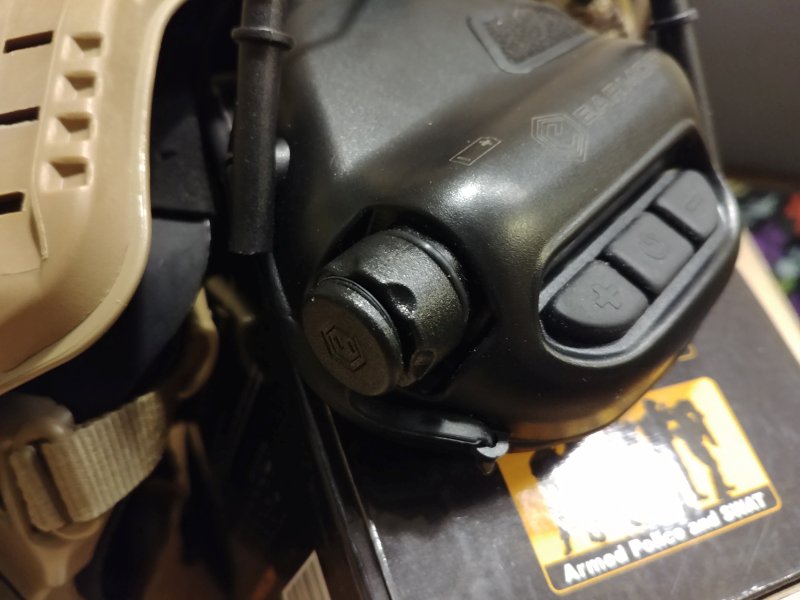 Auf beiden Seiten befindet sich ein Batteriefach. Man erkennt hier auch gleich die Gummierung um das Fach, sowie bei den Knöpfen. Dadurch ist der Gehörschutz IPX5 zertifiziert und man kann diesen bedenkenlos im Regen nutzen.
Auf beiden Seiten befindet sich ein Batteriefach. Man erkennt hier auch gleich die Gummierung um das Fach, sowie bei den Knöpfen. Dadurch ist der Gehörschutz IPX5 zertifiziert und man kann diesen bedenkenlos im Regen nutzen.  Zum Öffnen des Faches ist nur eine kleine Drehung notwendig. Betrieben wird der Gehörschutz mit zwei Stück AAA Batterien. Eine für jede Seite. Mit diesen haben die Earmor eine Laufzeit von 350 Stunden. Die Kappen sind zusätzlich mit einem Gummiband gesichert, damit diese nicht verloren gehen. Praktisch!
Zum Öffnen des Faches ist nur eine kleine Drehung notwendig. Betrieben wird der Gehörschutz mit zwei Stück AAA Batterien. Eine für jede Seite. Mit diesen haben die Earmor eine Laufzeit von 350 Stunden. Die Kappen sind zusätzlich mit einem Gummiband gesichert, damit diese nicht verloren gehen. Praktisch!  Seitliche Ansicht des Gehörschutzes. Die Aufnahme erinnert an Peltors. Oben erkennt man einen kleinen Klinkenstecker. Dort könnte das Mikrofon angesteckt werden, denn dieses lässt sich wechseln, je nachdem ob man es auf der linken oder rechten Seite tragen möchte. Die Höhenverstellung funktioniert auch wie bei Peltors und ist stufenlos.
Seitliche Ansicht des Gehörschutzes. Die Aufnahme erinnert an Peltors. Oben erkennt man einen kleinen Klinkenstecker. Dort könnte das Mikrofon angesteckt werden, denn dieses lässt sich wechseln, je nachdem ob man es auf der linken oder rechten Seite tragen möchte. Die Höhenverstellung funktioniert auch wie bei Peltors und ist stufenlos. 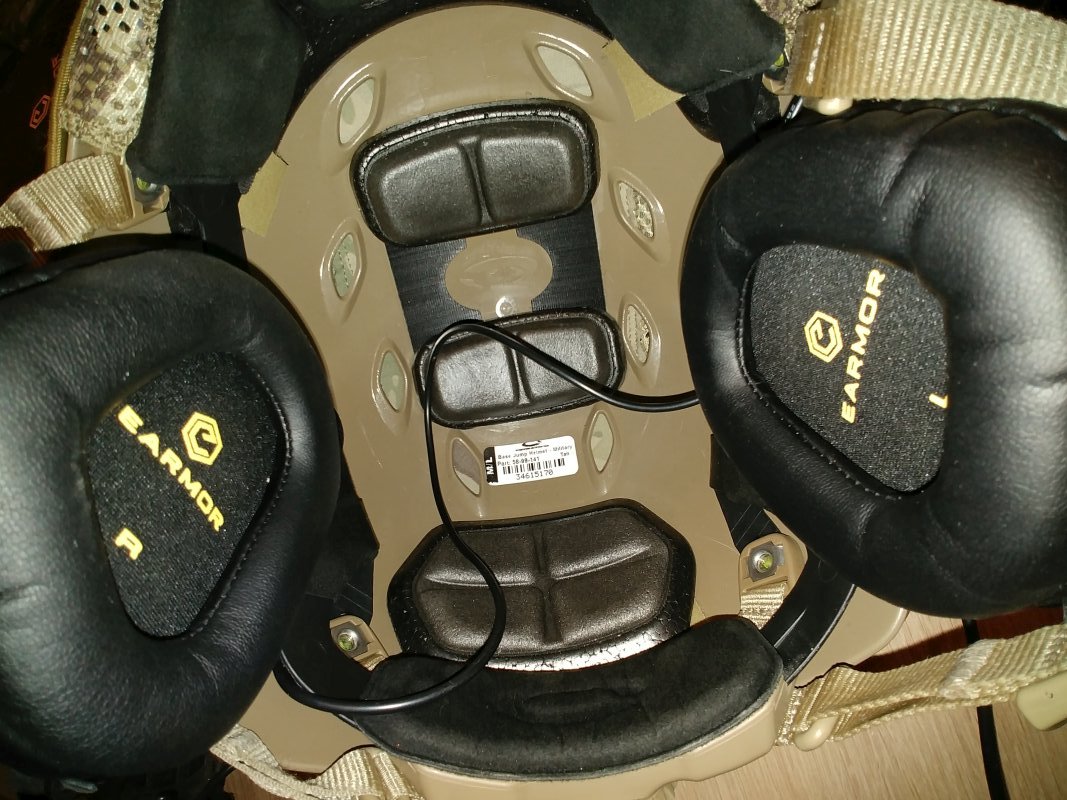 Innenansicht mit montiertem Gehörschutz auf einem Ops-Core Fast Base Jump Helm. Das Kabel bietet ausreichend Länge, um es eventuell auch auf der Außenseite über den Helm zu führen.
Innenansicht mit montiertem Gehörschutz auf einem Ops-Core Fast Base Jump Helm. Das Kabel bietet ausreichend Länge, um es eventuell auch auf der Außenseite über den Helm zu führen.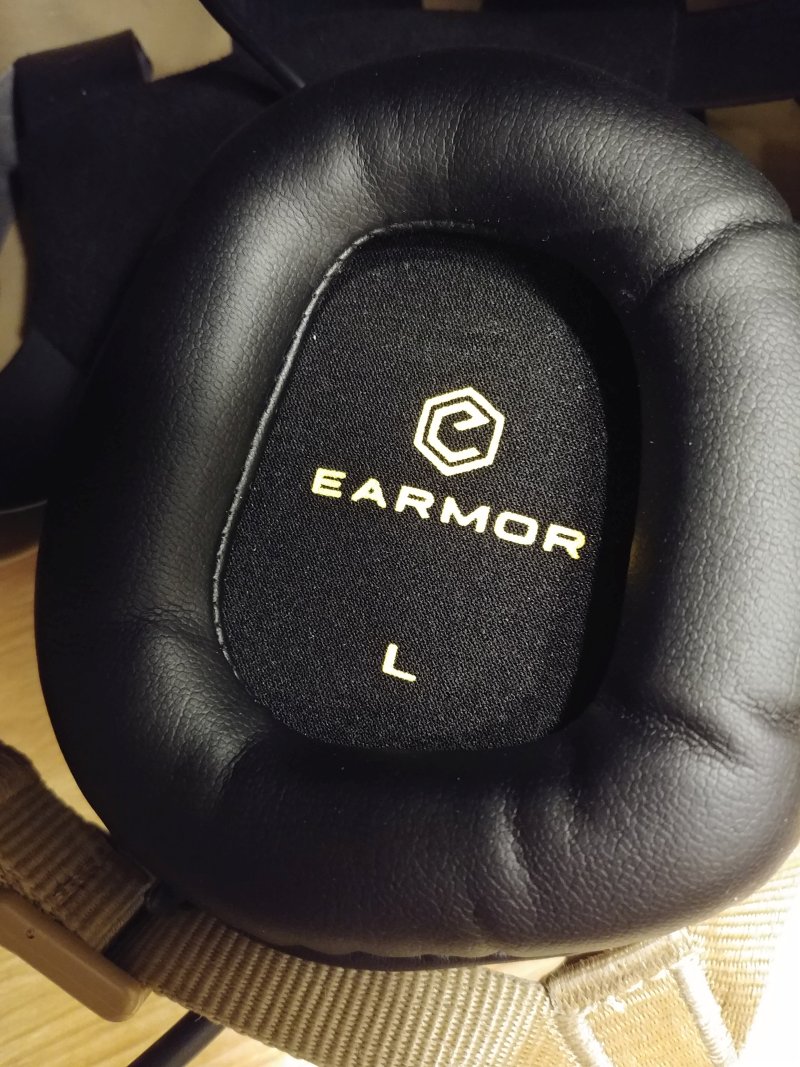 Die Ohrmuscheln sind gut geformt und bieten ausreichend Platz. Wirklich bemerkenswert ist, wie bequem sie sind. Der Schaumstoff ist weich und schmiegt sich gut an. Auch wenn Brillen getragen werden, drücken diese nicht. Der Schaumstoff und lässt sich aber leider nicht ohne weiteres entfernen und wechseln. Dieser dürfte aufgeklebt sein.
Die Ohrmuscheln sind gut geformt und bieten ausreichend Platz. Wirklich bemerkenswert ist, wie bequem sie sind. Der Schaumstoff ist weich und schmiegt sich gut an. Auch wenn Brillen getragen werden, drücken diese nicht. Der Schaumstoff und lässt sich aber leider nicht ohne weiteres entfernen und wechseln. Dieser dürfte aufgeklebt sein.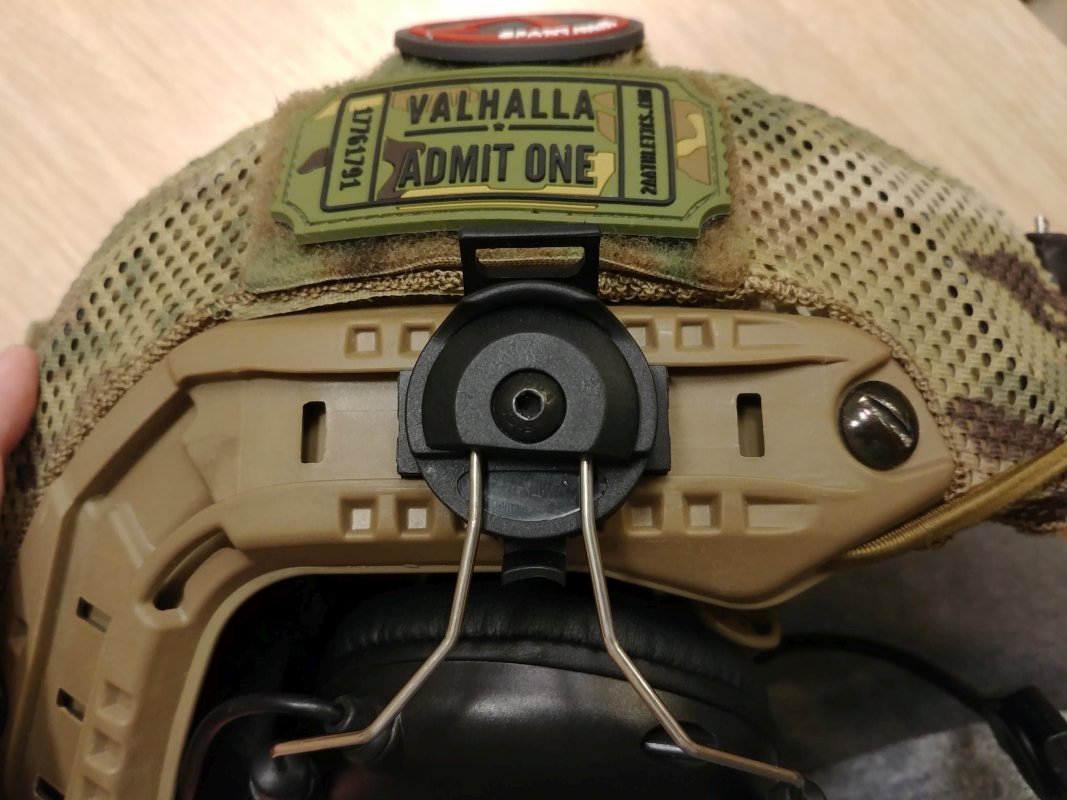 Aufnahme für die Ops-Core Schienen. Sie werden aufgesteckt und eine Art Flügel Sicherung rastet in die Aussparungen ein, damit das Headset nicht verrutscht. Negativ fällt uns leider auf, dass der Gehörschutz sich nicht drehen oder wegklappen lässt.
Aufnahme für die Ops-Core Schienen. Sie werden aufgesteckt und eine Art Flügel Sicherung rastet in die Aussparungen ein, damit das Headset nicht verrutscht. Negativ fällt uns leider auf, dass der Gehörschutz sich nicht drehen oder wegklappen lässt. 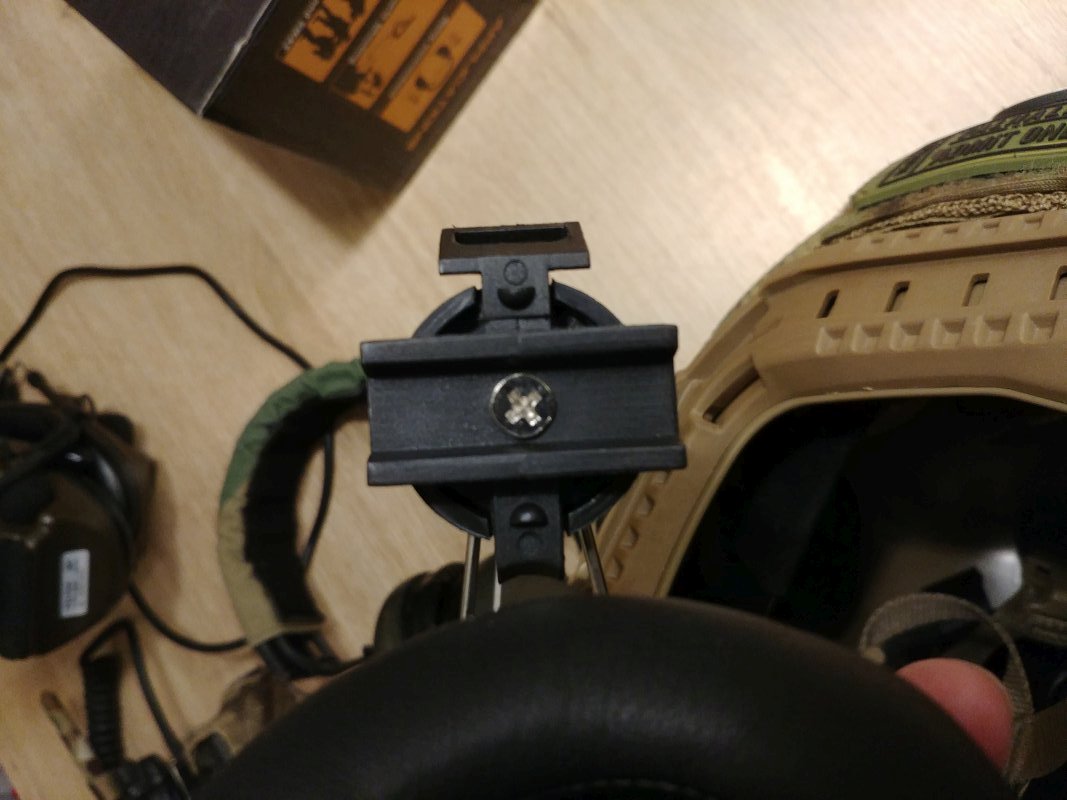 Innenansicht des Adapters. Plastik, und eine Sshraube. Nichts besonderes.
Innenansicht des Adapters. Plastik, und eine Sshraube. Nichts besonderes. 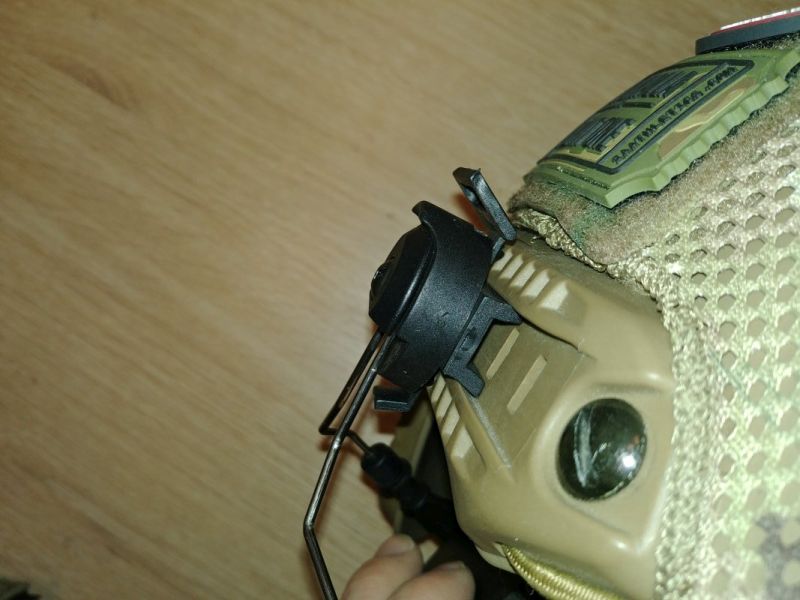 Hier die Sicht von vorne auf die montierten Adapter. Es lässt sich leider schwer zeigen, aber die Adapter sind zu locker in der Schiene. Diese haben Spiel, so dass sie nach oben und unten wackeln. Auch sind die Flügel, welche in der Schiene einrasten sollten, nicht streng genug und die Adapter verrutschen leicht. Wir konnten uns teilweise nur damit behelfen, in dem wir sie nachträglich etwas zurecht gebogen und Isolierband auf die Schienen geklebt haben.
Hier die Sicht von vorne auf die montierten Adapter. Es lässt sich leider schwer zeigen, aber die Adapter sind zu locker in der Schiene. Diese haben Spiel, so dass sie nach oben und unten wackeln. Auch sind die Flügel, welche in der Schiene einrasten sollten, nicht streng genug und die Adapter verrutschen leicht. Wir konnten uns teilweise nur damit behelfen, in dem wir sie nachträglich etwas zurecht gebogen und Isolierband auf die Schienen geklebt haben.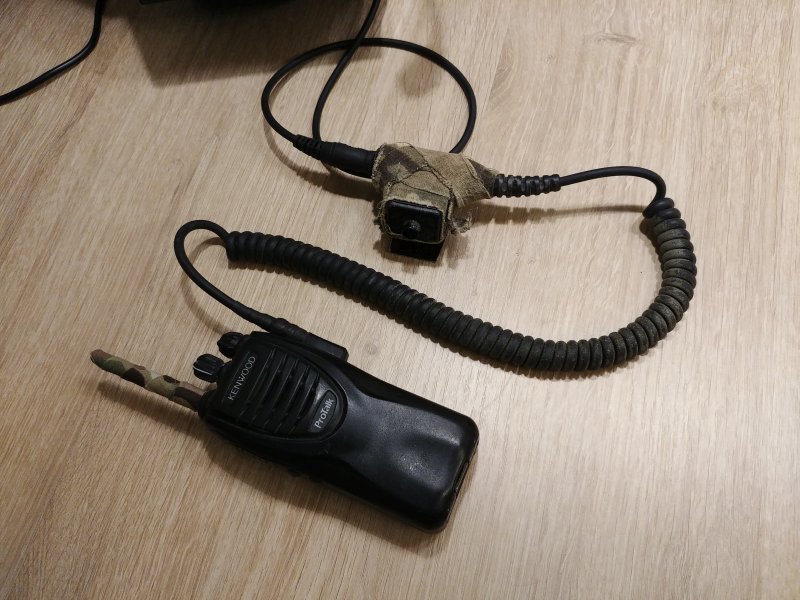 Zu beachten ist, dass die Earmor Headsets nur mit ihren eigenen PTT Einheiten funktionieren – oder auch mit NATO Mil. PTTs mit entsprechendem Nexus TP120 Stecker. Wir haben für unseren Test unsere Nexus U94 PTT Einheit mit einem Kenwood TK3301 verwendet, welches wir sonst mit unserem MSA Sordin nutzen. Hören funktioniert problemlos und die Sprachqualität ist sehr gut. Sprechen hat bei uns aber leider nicht geklappt. Das Mikrofon wurde dabei auf jeder Seite des Headsets angesteckt, um hier eine mögliche Fehlerquelle auszuschließen. Rücktest mit den Sordins und sprechen, der verlief erfolgreich.
Zu beachten ist, dass die Earmor Headsets nur mit ihren eigenen PTT Einheiten funktionieren – oder auch mit NATO Mil. PTTs mit entsprechendem Nexus TP120 Stecker. Wir haben für unseren Test unsere Nexus U94 PTT Einheit mit einem Kenwood TK3301 verwendet, welches wir sonst mit unserem MSA Sordin nutzen. Hören funktioniert problemlos und die Sprachqualität ist sehr gut. Sprechen hat bei uns aber leider nicht geklappt. Das Mikrofon wurde dabei auf jeder Seite des Headsets angesteckt, um hier eine mögliche Fehlerquelle auszuschließen. Rücktest mit den Sordins und sprechen, der verlief erfolgreich.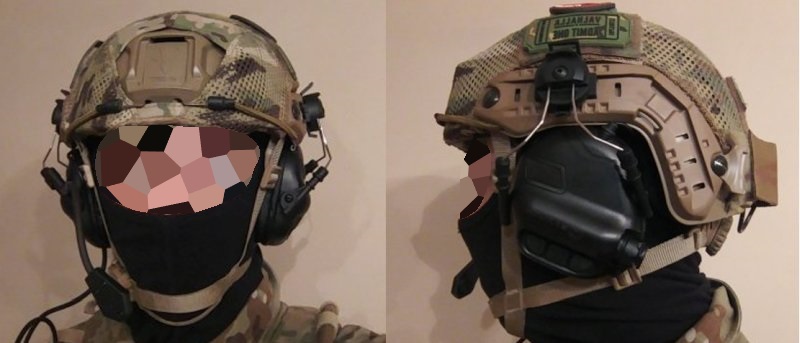 Hier ein Profilfoto mit den montierten Earmor M32.
Hier ein Profilfoto mit den montierten Earmor M32. Zum Audio Vergleich haben wir noch einen China Klon der 3M Peltor Comtacs.
Zum Audio Vergleich haben wir noch einen China Klon der 3M Peltor Comtacs. 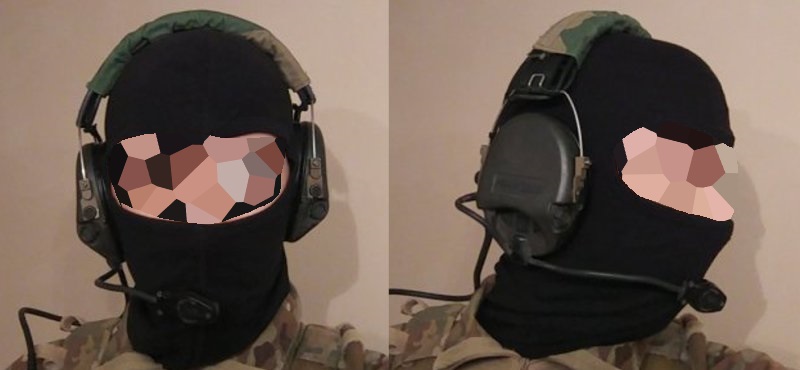 Und letztlich noch unsere bewähren MSA Sordins mit Gelkissen.
Und letztlich noch unsere bewähren MSA Sordins mit Gelkissen. Finaler Test der Audioqualität und ob sie wirklich ein aktiver Gehörschutz sind mit einer Knallgranate und 9 Millimeter Schreckschuß Munition. Zum Vergleich vorab: die Earmor haben einen Noise Reduction Rating (NRR) Wert von 22. MSA Sordins werden mit 18 angegeben und Peltor Comtacs mit 23. Das Rating ist aber leider nicht so einfach hinzunehmen, da ein lauter Knall dynamisch ist und die Frequenzbereiche nicht durchwegs alle gleich stark reduziert werden. Obwohl die Sordins mit nur 18 angegeben werden, so reduzieren sie rund 30 DB im Bereich eines Schusses. Wer sich gerne mehr damit beschäftigen möchte, findet HIER einen Link um sich weiter zu informieren.
Finaler Test der Audioqualität und ob sie wirklich ein aktiver Gehörschutz sind mit einer Knallgranate und 9 Millimeter Schreckschuß Munition. Zum Vergleich vorab: die Earmor haben einen Noise Reduction Rating (NRR) Wert von 22. MSA Sordins werden mit 18 angegeben und Peltor Comtacs mit 23. Das Rating ist aber leider nicht so einfach hinzunehmen, da ein lauter Knall dynamisch ist und die Frequenzbereiche nicht durchwegs alle gleich stark reduziert werden. Obwohl die Sordins mit nur 18 angegeben werden, so reduzieren sie rund 30 DB im Bereich eines Schusses. Wer sich gerne mehr damit beschäftigen möchte, findet HIER einen Link um sich weiter zu informieren.
Zurück zu den Earmor lässt sich sagen, dass sie funktionieren. Der Knall wird reduziert und der Gehörschutz macht zu. Auch ist nicht zu vergessen das die Earmor ANSI S3.19-1974 Standard zertifiziert sind. Wenn man die Frequenzbereiche der Sordins mit den Earmor vergleicht, so schneiden die Earmor sogar etwas besser ab in der Geräuschreduktion.
Wenn nicht geschossen wird, kann ein Aktivgehörschutz zeigen, was er kann, denn er ermöglicht es das man Gespräche normal hört, wie auch Umgebungsgeräusche. Die Earmor haben dabei aber leider ein Hintergrundrauschen, welches entsprechend lauter wird, je lauter man die Lautstärke erhöht. Gespräche sind gut zu hören. Verfälscht werden aber sonstige Umgebungsgeräusche. Schritte etwa bekommen ein unnatürliches rauschen, welches Anfangs irritierend ist. Da hat es uns verblüfft, da der Airsoft China Klon der Comtacs von der Audioqualität sogar besser war als die Earmor.
FAZIT: Leider hat uns das Headset nicht sehr überzeugt. Wir hätten uns gewünscht eine kostengünstige Alternative zu finden, aber die Kritikpunkte, wie etwa ein Adapter, der sich nicht bewegen lässt und schlecht sitzt, sowie die Audioqualität, die nicht überzeugt, lassen uns zu dem Schluss kommen, dass man doch etwas mehr Geld in die Hand nehmen sollte, um sich einen bewährten Gehörschutz zu leisten. Schade! Was aber positiv bleibt, ist der Preis, die Verarbeitung und die unglaubliche Bequemlichkeit. Sie wären wohl einzig eine alternative für Personen, welche einen aktiven Gehörschutz mit Headset/Sprach Funktion suchen. Dafür könnte man sie in Betracht ziehen, wobei dies eher mehr auf Airsoft Spieler und ähnliches abzielt.
Aber Achtung: Es gibt MOD1 Modelle – Anfänglich haben wir sie kurz erwähnt. Ab nun gibt es bereits die neuen MOD1 Modelle des M32 Gehörschutzes. Hierbei wurde die Elektronik überarbeitet, sowie die Robustheit wurde ebenso nochmals verstärkt. Die Pads haben nun etwas härteren Schaumstoff und bei den Modellen mit Helm Adapter, sind diese nun schwenkbar. Wo manchmal ein Sticker den Gehörschutz zierte, wurde dieser durch Laser Gravur ersetzt.
Im Prinzip wurde bei den MOD1 – wir werden sie euch demnächst ausführlich vorstellen – nahezu alles behoben, was uns gestört hat. Wir sind daher gespannt. Die alten Modelle, gibt es nur noch vereinzelt in Shops, daher achtet bei einem möglichem Kauf, das ihr am besten die neuen MOD1 nehmt.
Wenn ihr euch für die Earmor interessiert, so findet ihr sie HIER.
OPSMEN im Internet: www.opsmen.com
Die hier gezeigten Earmor für die Helm Rail gibt es günstig in Aktion zur Zeit beim TACSTORE.AT. Alle anderen Modelle im Shop sind ansonsten bereits die wertigen MOD1 Modelle.
TACSTORE im Internet: www.tacstore.at
SPARTANAT ist das Online-Magazin für Military News, Tactical Life, Gear & Reviews.
Schickt uns eure News: [email protected]
Werbung
Hol Dir den wöchentlichen SPARTANAT-Newsletter.
Dein Bonus: das gratis E-Book von SPARTANAT.


